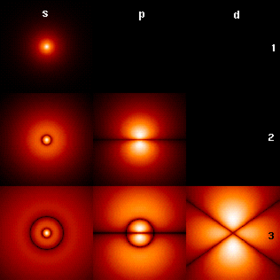အီလက်ထရွန်
(
e−
သို့မဟုတ်
β−
ဟု သင်္ကေတ ပြရိုးရှိသော)အီလက်ထရွန် (အင်္ဂလိပ်: electron; တိုက်ရိုက်ဘာသာပြန်လျှင် လျှပ်မှုန်) သည် ဒြပ်ပမာ 9.1093837 × 10-31 kg ရှိ၍ လျှပ်မဓာတ်ဆောင်သော လက်ပတွန် တစ်မျိုးဖြစ်သည်။ အခြားလက်ပ်တွန်များထက် သက်တမ်းခံတည်ငြိမ်သဖြင့် သဘာဝ၌ များစွာသောအက်တမ်တို့၏ အက်တမ်အောက်အမှုန်အဖြစ် တွေ့နေကျဖြစ်သည်။ လျှပ်မဓာတ်(negative charge) ဆောင်သည်[၈] တွင် ၎င်း၏ လျှပ်ဓာတ်ပမာဏ 1.602176634×10−19 C ကို လုံးချင်းလျှပ်ဓာတ် (elementary charge) အဖြစ် အမှုန်ရူပဗေဒ၌ စံထား သုံးနှုန်းကြသည်။ အက်တမ့် ဗဟိုဆန် (Nucleus) ဘေးပတ်လည်တွင် ဝဲခိုတည်ရှိနေတတ်သည်။ လှိုင်းသဘာဝရော အမှုန်သဘာဝပါဆောင်သည်။ အီလက်ထရွန် အရေအတွက်နှင့် ပရိုတွန် အရေအတွက်ကို အခြေခံ၍ အိုင်းယွန်း (ion) များ ဖြစ်ပေါ်လာသည်။
အီလက်ထရွန်၏ လည်အင်(spin)မှာ ½ ဖြစ်၍ ဖာမီယွန်အုပ်စုထဲတွင် ပါဝင်သည့် အမှုန် ဖြစ်သည်။ သို့ဖြင့် ပါအူးလီ ကန့်ပယ်စည်းမျဉ်း (Pauli Exclusion Principle) ကို လိုက်နာသည်။
၎င်း၏ သေးငယ်သော ဒြပ်ထုကြောင့် ကွမ်တမ် သဘောယန္တရားအရလည်း အက်တမ့်ဗဟိုဆံကဲ့သို့ သေးငယ်သော ထုထည်အဝန်းအဝိုင်းအတွင်းသာ ကျရောက်မနေဘဲ အက်တမ်တစ်ခု၏ လွတ်လပ်တတ်သော အပိုင်း ဖြစ်သည်။ ထို့ကြောင့် ဓာတုဓာတ်ပြုမှုများတွင် အီလက်ထရွန် ဖြန့်ကျက်ပုံ (electron configuration) က အရာဝတ္ထုများ၏ သဘောသတ္တိများစွာကို အဆုံးအဖြတ် ပေးသည်။ သတ္တုများက လျှပ်ကူးပစ္စည်း ဖြစ်ရခြင်းမှာလည်း ၎င်းတို့၌ လွတ်လတ်သော အီလက်ထရွန်တို့ များပြားခြင်းကြောင့် ဖြစ်သည်။
 Hydrogen atom orbitals at different energy levels. The brighter areas are where one is most likely to find an electron at any given time. | |
| ပါဝင်မှု | အခြေခံအမှုန် |
|---|---|
| စာရင်းဝင် | ဖာမီယွန် |
| မျိုးဆက် | ပထမဆုံး |
| အတွင်းစည်း | ဒြပ်ဆွဲမှု၊ လျှပ်စစ်သံလိုက်ဓာတ်၊ အပျော့စက် |
| သင်္ကေတ | e− , β− |
| ဆန့်ကျင်ဘက်အမှုန် | ပိုစီထရွန် (also called antielectron) |
| သီအိုရီပြု | Richard Laming (၁၈၃၈–၁၈၅၁),[၁] George Johnstone Stoney (1874) and others.[၂][၃] |
| ရှာဖွေတွေ့ရှိခဲ့ | ဂျေဂျေ သော်မဆင် (၁၈၉၇)[၄][၅] |
| ဒြပ်ထု | 9.10938356(11)×10−31 kg[၆] 5.48579909070(16)×10−4 u[၆] [1822.8884845(14)]−1 u[note ၁] 0.5109989461(31) MeV/c2[၆] |
| သက်တမ်း | stable ( > 6.6×1028 yr[၇]) |
| လျှပ်စစ် | −1 e[note ၂] −1.6021766208(98)×10−19 C[၆] −4.80320451(10)×10−10 esu |
| သံလိုက်ရွေ့လျားမှု | −1.00115965218091(26) μB[၆] |
| စပင် | 1/2 |
| အားပျော့သော အိုင်ဆိုစပင် | LH: −1/2, RH: 0 |
| Weak hypercharge | LH: -1, RH: −2 |
ရှာဖွေတွေ့ရှိမှု ပြင်ဆင်ရန်
ရှေးအခါက ဒြပ်စင်တို့၏ အသေးငယ်ဆုံးသော အစိတ်အပိုင်းသည် အက်တမ်ပင်ဖြစ်၍၊ ထိုထက်ငယ်သော အစိတ်အပိုင်း မရှိနိုင်ဟု ယူဆလာခဲ့ကြလေသည်။ သို့သော် ဆာ ဂျေဂျေ သွန်မဆင် ဆိုသူ ကိန်းဘရစ်ချ် တက္ကသိုလ်ပါမောက္ခကြီး တစ်ဦးက အက်တမ်အောက် အလွန်ငယ်သော အစိတ်အပိုင်းတို့ရှိကြောင်းကို ခရစ် ၁၈၉၇ ခုနှစ်တွင် ရှင်းလင်းပြသ၍ ထိုအစိတ်အပိုင်းတို့ကို အီလက်ထရွန် (လျှပ်မှုန်) ဟု အမည်ပေးခဲ့လေသည်။ ဟိုက်ဒြိုဂျင်သည် ဓာတုဒြပ်စင်တို့တွင် အပေါ့ဆုံးဖြစ်၍ ယင်း၏အက်တမ်အလေးဆသည် ၁.ဝဝ၈ မျှသာ ရှိ၏။ အီလက်ထရွန်တစ်ခု၏ အလေးချိန်မှာ ထိုဟိုက်ဒြိုဂျင် အက်တမ်၏ အလေးချိန်ကို အပုံ တစ်ထောင့်ရှစ်ရာ လေးဆယ့်ငါးပုံ ပုံလျှင် တစ်ပုံ (၁/၁၈၄၅) ခန့်သာရှိလေသည်။[၉]
ကိုးကား ပြင်ဆင်ရန်
- ↑ Farrar, W.V. (1969). "Richard Laming and the Coal-Gas Industry, with His Views on the Structure of Matter". Annals of Science 25 (3): 243–254. doi:.
- ↑ Arabatzis၊ T. (2006)။ Representing Electrons: A Biographical Approach to Theoretical Entities။ University of Chicago Press။ pp. 70–74။ ISBN 0-226-02421-0။
- ↑ Buchwald၊ J.Z.; Warwick၊ A. (2001)။ Histories of the Electron: The Birth of Microphysics။ MIT Press။ pp. 195–203။ ISBN 0-262-52424-4။
- ↑ Thomson, J.J. (1897). "Cathode Rays". Philosophical Magazine 44 (269): 293–316. doi:.
- ↑ Thomson၊ J.J. (1906)။ Nobel Lecture: Carriers of Negative Electricity။ Nobel Foundation။ 10 October 2008 တွင် မူရင်းအား မော်ကွန်းတင်ပြီး။ 2008-08-25 တွင် ပြန်စစ်ပြီး။
- ↑ ၆.၀ ၆.၁ ၆.၂ ၆.၃ ၆.၄ P.J. Mohr, B.N. Taylor, and D.B. Newell, "The 2014 CODATA Recommended Values of the Fundamental Physical Constants". This database was developed by J. Baker, M. Douma, and S. Kotochigova. Available: [၁]. National Institute of Standards and Technology, Gaithersburg, MD 20899.
- ↑ Agostini M. et al. (Borexino Coll.) (2015). "Test of Electric Charge Conservation with Borexino". Physical Review Letters 115 (23): 231802. doi:. Bibcode: 2015PhRvL.115w1802A.
- ↑ JERRY COFF။ 10 September 2010 တွင် ပြန်စစ်ပြီး။
- ↑ မြန်မာ့စွယ်စုံကျမ်း၊ အတွဲ(၁၄)
မှတ်စု ပြင်ဆင်ရန်
| ဤ ရူပဗေဒနှင့် သက်ဆိုင်သော ဆောင်းပါးမှာ ဆောင်းပါးတိုတစ်ပုဒ် ဖြစ်သည်။ ဖြည့်စွက်ရေးသားခြင်းဖြင့် မြန်မာဝီကီပီးဒီးယားကို ကူညီပါ။ |